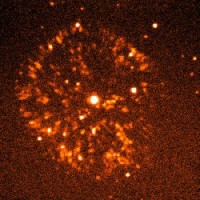 In 1901 this impressive nova occurred, which for a short while could keep up with the brightest stars in the sky. In less than two days the star increased its brightness 10,000 times. The double star GK Persei is an unusual nova star. Both partners are relative far away from each other, which makes a flowing of matter from the bigger partner to the white dwarf difficult. |
Novae are now known to be caused by a star briefly re-igniting after having lain dormant for many years. Stars shine due to the nuclear fusion reactions in their cores, which process hydrogen into helium, releasing energy in the process. When the hydrogen is used up, sun-like stars slough off their outer envelopes, and become very small, very hot "white dwarfs." These white dwarfs are the inert cores of dead stars which have used up all of their available fuel.
Now, stars often come in pairs, or "binaries," where two stars are in orbit around each other. If one of the stars in a binary is a white dwarf, and the other begins evolving into a red giant (a stage near the end of the life of a star, but before the white dwarf stage), the white dwarf can begin gravitationally attracting some of the gas from the atmosphere of the red giant to itself. Most of this gas will be hydrogen, and when the hydrogen reaches the surface of the incredibly hot white dwarf, it rapidly ignites, creating a large nuclear explosion on the surface of the star. This is what we see in our sky as a nova.